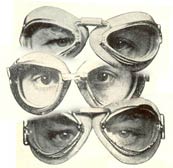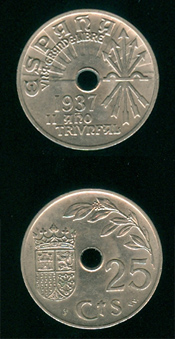|
This page contains two biographies, one for Gordon Squire Barry and the other for Gordon King Berry. Read on to discover why. Only the former signed the Register.
Brownsville Herald, June 23, 1930 (Source: newspapers.com)
 |
Gordon Squire Barry, 1939 (Source: Woodling)
 |
First, Gordon Squire BARRY did sign the Davis-Monthan Register on Thursday, August 28, 1930 at 2:00 PM. His portrait, left, is from the El Paso Herald-Post, October 25, 1939. He carried two unidentified passengers in a Lockheed Vega with Mexican registration, X-ABH (nee: NC2846). They were based in Torreon, Mexico, and were on their way northwest from Tucson to Los Angeles, CA. From the history of the airplane, q.v., it is fairly clear that this was a commercial transport flight for Corporacion Aeronautica de Transportes,
S.A. (CAT), based at Torreon. Barry was a pilot for CAT.
The El Paso Herald-Post, November 16, 1937 (Source: newspapers.com)
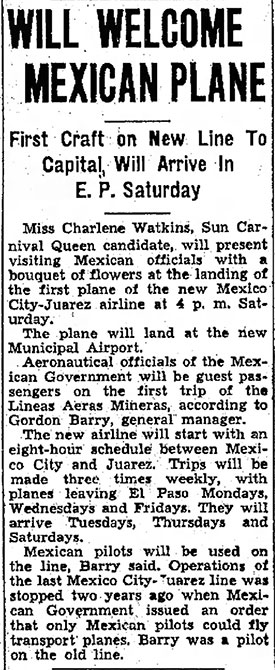 |
South Texas newspapers from the summer and fall of 1930 included numerous records of CAT traffic, like the article at right from the Brownsville Herald, June 23, 1930. Note Barry's mention twice just below the midpoint of the article.
Barry learned to fly in Los Angeles ca. 1927, so was a relatively new pilot when he went to Mexico and flew for CAT. CAT went out of business in 1932, but Barry contracted with the San Luis Mining Company to fly its gold and silver bars, mail and freight between Mazatlan and its mine in Durango (about 62 miles). Barry's operation was successful and he formed his own airline company to carry on the business.
Thus, a couple of years later, in 1934, Barry founded Lineas Aereas Mineras, S.A. (LAMSA, or "Mining Airlines"). As his airline developed, he added new routes as time, technology and the government allowed. Note on the map below, the route from Mazatlan to La Paz, across the open water of the Gulf of California, which was opened in 1936..
LAMSA later flew a route from Mexico City to Juarez, Mexico, just across the border from El Paso, TX. The El Paso Herald-Post of September 21, 1937 announced the approval of the service, and The El Paso Herald-Post, November 16, 1937, left, documented the first landing on the new route.
Interestingly, traffic to the Juarez airport was not allowed to land there until September 1938, because the airport was unsuitable (note that the article at left specifies that the first landing was made in El Paso across the border). An article from the El Paso Herald-Post, October 25, 1939, below, provided a biographical perspective on Barry and his airline.
El Paso Herald-Post, October 25, 1939 (Source: Woodling)
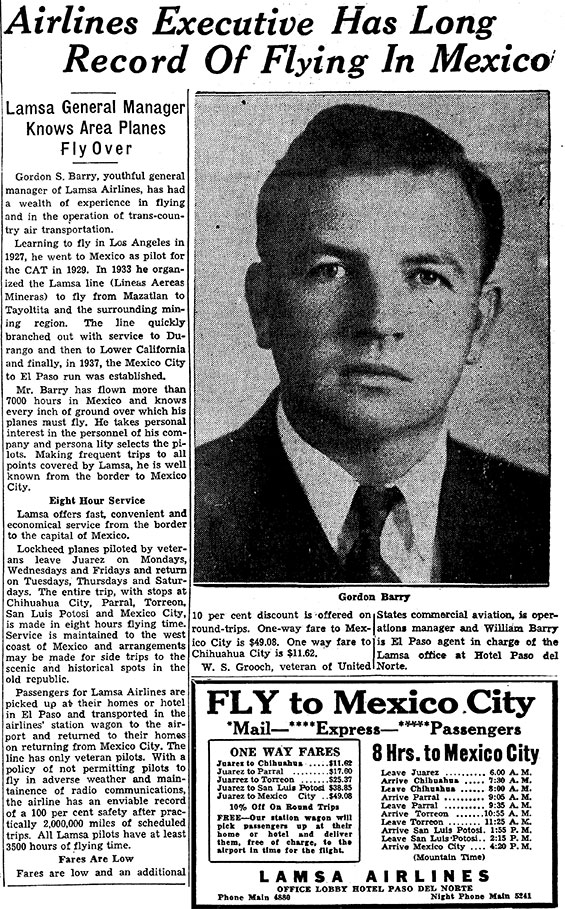 |
The LAMSA airlines schedule appeared on the same page. According to the itineraries, passengers could leave Juarez in the morning and be in Mexico City eight hours later, with four stops in between. News articles weren't the only press Barry received. He appeared in American Aviation, October 15, 1937 speaking about the proposed El Paso to Mexico City route.
The El Paso Herald-Post, January 21, 1938 (Source: newspapers.com)
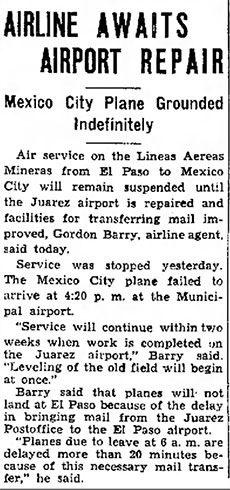 |
The El Paso Herald-Post, January 21, 1938, right, reported the condition of the Juarez field. It wasn' t all field condition, however. It was timing, too, in that it took too long to move mail from Juarez to El Paso. Not to worry though, because about the same time the routing from Torreon west was under development (map below), so there was plenty of traffic to support the business. All routes, besides passengers, included freight and mail contracts.
Please direct your browser to this link, which goes into detail about the formation, management and life of LAMSA. A map of LAMSA's routes as of 1943 is below, from the link. By March 1943, LAMSA had about 100 employees and flew 15 airplanes, all over ten years old. As successful as it was, LAMSA was merged into United Airlines in 1943.
The merger was carried out in despite the fact that LAMSA was described in 1943 as having been "conducted on somewhat of a barnstorming basis." Less than a decade earlier it had begun with only one pilot, Barry, and two airplanes, one of which was on the ground or in the shop most of the time.
Part of United's due diligence before acquisition of LAMSA stated, "At present the company has seven servicable airplanes which include five 7-place Lockheed Vegas with 550 horse-power Wasp engines, one 5-place Lockheed Vega with a 400 horse-power Pratt & Whitney engine, and one tri-motored Bach, eqluipped with one Wasp and two Wright engines. This latter airplane is used for the short run between Mazatlan and Tayoltita. The company owns four more 7-place Lockheed Vegas, two of which should be serviceable by April 1st, another about April 15th, and another about May 1st."
The El Paso Herald-Post, September 28, 1943 (Source: newspapers.com)
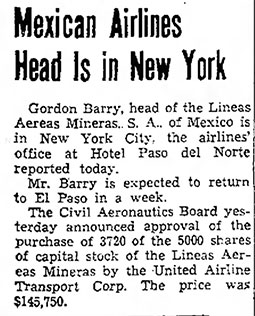 |
Further, "They also have two more tri-motored Bachs which are practically wrecked, but which they feel can be made serviceable within a few months if necessary. They also own a Sikorsky S-38B which apparently could be made serviceable without spending too much money. The company has at Torreon a Curtiss Robin with a Challenger engine and this whole airplane needs a thorough overhauling and probably some new parts before it can be flown."
Aircraft maintenance was equally as spotty, with homemade master rod bearings and valve guides, with wheels locally crafted from melted aluminum pistons, propellers dressed thin, and landing gear made from old automobile frames with little regard to temper or tensile. Thus was the description of Barry's working airline and infrastructure after a decade of development.
United concluded, though, "In spite of the conditions under which the company was forced to operate, however, it achieved an outstanding record of never injuring a passenger, at the same time attaining a high degree of good will." The good will was due to the force of Barry's personality. Barry was in New York for the United merger signin according to The El Paso Herald-Post, September 28, 1943, left. Contrary to what the newspaper said, the LAMSA history link, above, identified the number of shares purchased by United as 3,750, not 3,720. The official date of the acquisition was recorded as October 1, 1943. Barry left the company upon its acquisition.
LAMSA Routes, 1943 (Source: LAMSA Link)
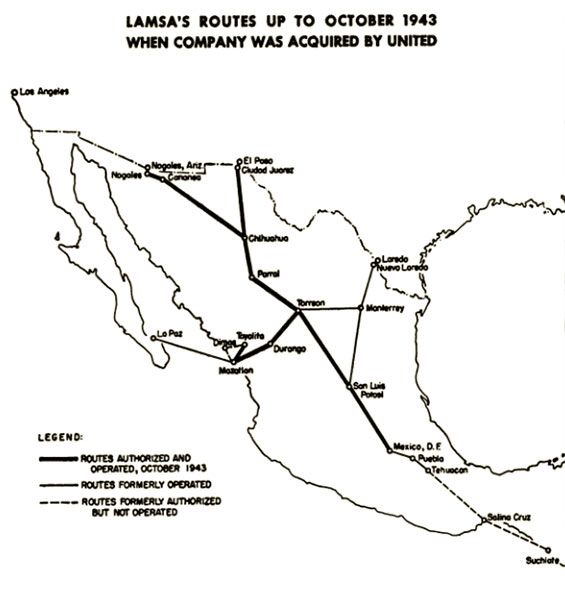 |
The 1910 U.S. Census for Barry, his first, placed him at five-months old living with his father, Benjamin C. (age 37) and mother, Rosemond (26) in Santa Barbara, CA. A boarder lived with them. Barry's father was a hay farmer.
The 1920 Census placed him at age ten living in the household of his great aunt at 559 South Gramercy Place, Los Angeles, CA. This neighborhood today is one of contemporary, multi-family apartment buildings. His parents and three younger siblings lived with them, as well as three boarders.
The family was still together in Los Angeles in 1930 according to the Census that year. Barry's occupation was coded as "Pilot." He was 20 years-old and single. His father had taken up brokering real estate.
Immigration forms among his papers at ancestry.com documented numerous flights made by Barry on scheduled airlines into and out of Mexico. For example, On December 24, 1943 he flew from Mexicali to Los Angeles aboard XA-CAG was Pan American's DC-3-228C NC25641. He was accompanied by his wife, Judith (née Martinez; age 32; 1912-1983). On another occasion, January 22, 1944, he left El Paso for Monterrey aboard NC25661, a Douglas DC-3 (S/N 2206; built in 1940). On October 15, 1944 he flew from Mexico City to El Paso aboard NC21747. I found no purpose listed for these trips.
The following Immigration form is instructive, because it is the last record I found that identified Barry as a member of the flight crew. He acted as copilot for Raul Espanda aboard XA-DUP [sic, I could find no Mexican aircraft registered XA-DUP] operated by Red Aereas Mexicana S.A. After leaving LAMSA and United in 1943, Barry established an all-freight airline, Red Aereas Mexicana S.A. (RAMSA) that first flew in late 1943.
Only one Mexican airliner was registered "XA-DU-." It was XA-DUS, a DC-3. Was the "U" really an "O" with the loop incomplete? There was no "XA-DOP" either. There were eleven Mexican transport aircraft registered "XA-DO-," but none wore the final "P." And only two of those operated with Red Aereas Mexicana S.A., a Curtiss-Wright T-32C Condor, XA-DOA, and XA-DOK, a Lockheed Vega née NC898E. The Condor and Vega were the aircraft of Barry's freight line. RAMSA operations ceased in 1947. If you are familiar with XA-DUP, please let me KNOW.
U.S. Immigration Form, July 20, 1946 (Source: ancestry.com)
 |
Note, too, on this flight, that Barry's wife and son, Gordon, Jr., age 2 (1944-1980), were on board. Both were identified as citizens of Mexico. Mrs. Barry was an experienced traveler to the U.S., having lived in San Francisco from August 9, 1927 to December 1936, and then visited from Mexico frequently during the late 1930s. Border crossing manifests identified her as 5'5" tall with black hair and brown eyes.
Another immigration form placed Barry at age 37 on an American Airlines flight from Mexico City to El Paso, TX on December 6, 1946. He flew with thirteen fellow passengers and three crew, including his wife. Their airplane was NC39544, a Douglas C-53D-DO (ex-military "Skytrooper"). On January 23, 1947 he flew from Mexico City to El Paso aboard the Douglas DC-4 NC90439. None of the flights suggested Barry's purpose for travel.
Sadly, another form among his papers was a death certificate for his second son, Charles Valentine-Barry Martinez. Born in Santa Monica, CA, he died in Mexico on May 30, 1947 at age three months of bronchial pneumonia.
Gordon Squire Barry was born December 10, 1909. He flew West on March 17, 1991 from San Rafael, Marin County, northern California. He carried Transport pilot certificate T866.
---o0o---
G.K. Berry, ca. 1936 (Source: NASM)
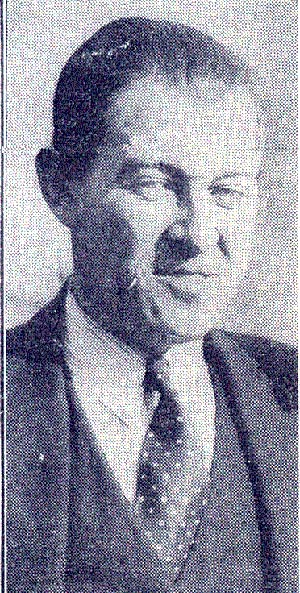 |
Pilot Gordon King BERRY did not sign any Register, but, curiously, his information was found in the NASM biographical file labeled Gordon S. Barry (referenced in the left sidebar). Essentially, information for Berry, a different pilot, was in the NASM folder.
That file contains a single, undated newspaper article. From the context, however, the date of the article was near December 24, 1936. It describes the work of Berry, not Barry. Berry's image, left, is from that article, and it was labeled "Captain Gordon Barry.".
The article describes Berry's participation in the "Yankee Squadron" during the Spanish Civil War (1936-1939). He had served in the RAF toward the end of World War I. Berry was a 39 year old New Yorker. He was flying and drinking companion of Pitcairn Field Register pilot Bert Acosta. Acosta was among the American pilots recruited to fly for anti-Franco Republican loyalists during that Civil War. Barry was one of his recruits. Adding to the confusion, Berry is identified was "Gordon O. Berry" in a November 21, 1936 news article on Acosta's Web page.
Regardless, from the same 1936 article: "As loyalist bombing planes [Berry flew one] escorted by American-piloted pursuit ships [another article from Marshall News Messenger (TX), below, identified the pursuit pilots as Russian] took off yesterday to bomb Burgos [in northern Spain], the Spanish rebel headquarters, between ten and twenty persons, including women and children, were slain in Madrid streets on Christmas Eve by shells from Fascist artillery and bombs from insurgent planes.
"The Yankee Squadron, most daring of the aviatiors fighting with the Spanish loyalists, swept over the rebel capital of Burgos tonight.
El Paso Herald-Post, December 29, 1936 (Source: newspapers.com)
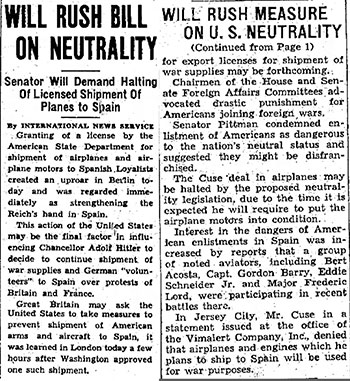 |
"The American flyers, led by Bert Acosta, escorted a fleet of bombers in a raid on the insurgents' capital, one of their most heavily fortified positions. They carried hundreds of incendiary bombs to drop on hangars and munition dumps around Burgos in an effort to destroy General Francisco Franco's planes and artillery, which have wrecked much of Madrid."
With a hint of swashbuckle, the NASM article continues, "Acosta and his companions abandoned plans for a Christmas Eve celebration in Biarritz, French resort across the frontier, to embark on the bombing foray. They referred jokingly to the bombs which they stowed away beneath the planes as 'messages of Christmas cheer for the boys in Burgos.'"
A dated and sourced article from the El Paso Herald-Post, left, provides the broader geopolitical perspective on the story quoted above from the NASM folder. Note the misspelling of Berry's name.
El Paso Herald-Post, January 4, 1937 (Source: newspapers.com)
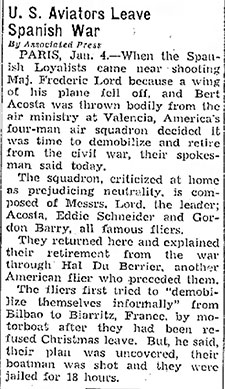 |
The swashbuckle continued a week later when Berry's informal squadron disengaged from the conflict, right, from the El Paso Herald-Post, January 4, 1937. Their disengagement was via their escape to Paris. An immigrations form I reviewed at ancestry.com documented his return to the U.S. on January 14, 1937 aboard the French liner S.S. Paris. Bert Acosta was aboard the same ship.
Another article, below from the Marshall News Messenger (TX), January 7, 1937 tells about what it was like to fly for the Spanish Republican/Loyalists in the late 1930s during the Spanish Civil War. This article mentions some of the same people from the article pictured at right, but goes into more detail. The author of the article was Lord. The tale is one of harrowing flying, in substandard aircraft, in a disorganized, undisciplined squadron. Berry's name was also misspelled in that article.
The International Brigades, as foreigners were called who aided the Republicans during the Civil War, numbered in the thousands. But, as the article implies, militarily they were never very significant. Barry was part of the air arm of the Brigades.
If you want more about the Spanish Civil War, only from the foot soldier's viewpoint, the very readable book Homage to Catalonia (1938) by George Orwell is excellent. A stroll today around Barcelona will bring you to to historic sites (Hotel Colon) and neighborhoods (Las Ramblas) mentioned in Orwell's book. Orwell was shot in the neck during the conflict (but survived to write Homage and Animal Farm and 1984 some years later). Eventually his side, the Republicans, lost the war to the Nationalists and General Francisco Franco became dictator from 1938 until he died in 1975. But, I digress, below is the article from January 7, 1937. I left the contemporary motion picture reviews for your enjoyment at lower right.
Marshall News Messenger (TX), January 7, 1937 (Source: newspapers.com)
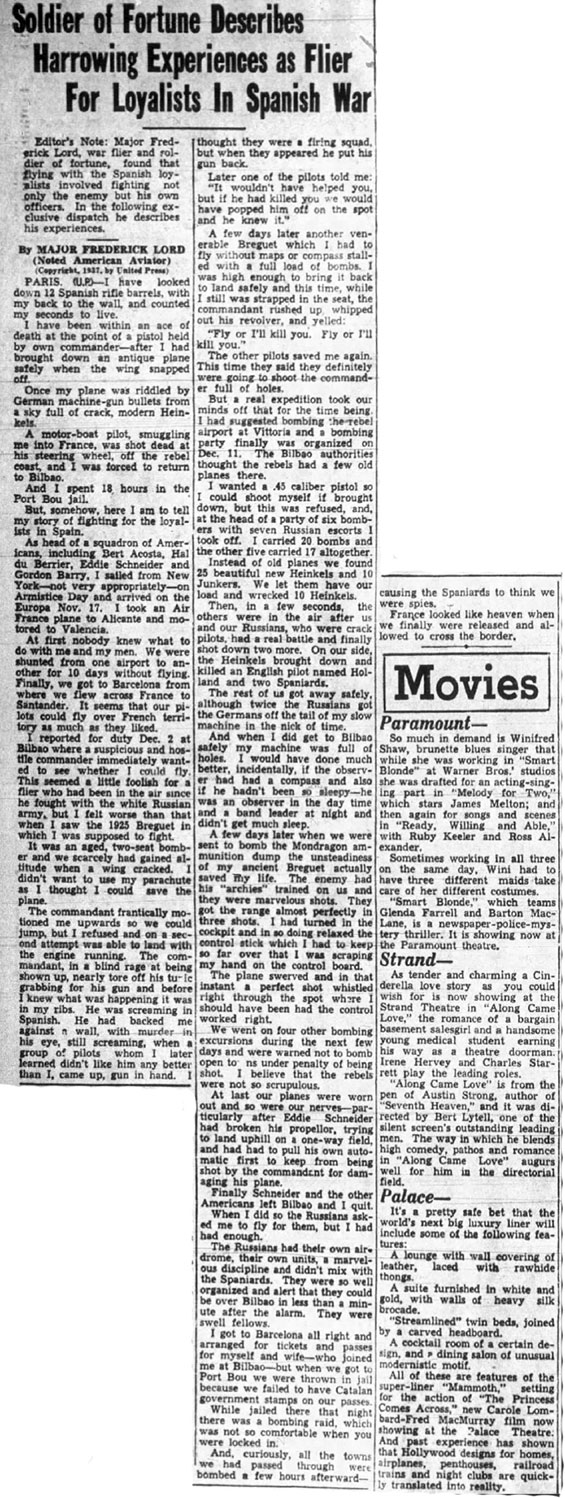 |
Finally, The New York Times, January 15, 1937 described the homecoming and welcome received by Acosta and Berry. The photo of Berry (on the right in the photo) matches the one above found in the NASM folder. Several other news articles appeared that documented a lawsuit brought by Acosta and Berry against the Spanish government for failure to pay them for their service. As far as I was able to tell, no monetary resolution was ever forthcoming. C'est la guerre.
The New York Times, January 15, 1937 (Source: NYT via Woodling)
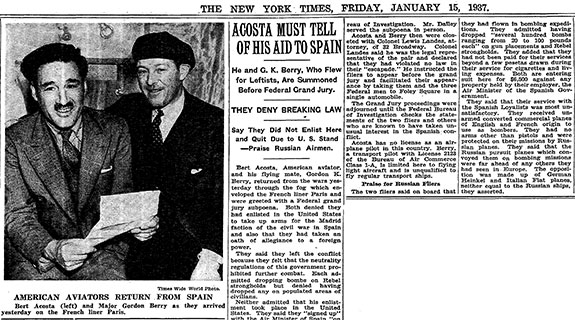 |
Here are a few points about Berry's earlier life. During WWI, he enlisted in the New York National Guard on June 20, 1916. He was honorably discharged from the Guard on July 24, 1917. He later joined the (Canadian) Royal Flying Corps and saw some action on the European front. I don't know when or where he learned to fly.
Berry Family Burial Plot (Source: findagrave.com)
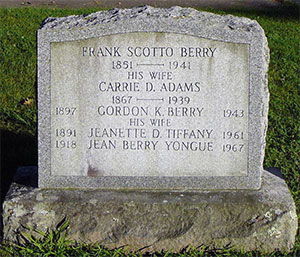 |
Berry was married January 31, 1917 (another source says February 3rd) to Jeanette DuBois Tiffany (8/24/1891-1961). The 1920 U.S. Census placed Berry (age 22) living with Jeanette (21) at 20 Arlington Road, Stamford, CT with their one-year-old daughter, Jean (1918-1967). That address today is a modest yellow, two-storey frame home on a street of other modest residences. His occupation was coded as "Salesman."
The 1930 Census is confusing, in that Berry is living with Marjorie, a woman identified as his wife, in New Hampshire. His occupation was coded as "Pilot" in the "Aviation" industry. The Census further indicated they had been married one year. If anyone can clarify this curious information, please let me KNOW.
The 1940 Census placed him living with his (original) family at 64 Bank Street, New York. Jeanette's occupation was coded as "Real Estate," Berry was an aviator and Jean, now age 21, was coded as a "Speech teacher." They lived in a brick row house they rented for $30 per month in what is today a tony neighborhood. Berry allegedly graduated from Worcester Polytechnic in 1918, but the 1940 Census form coded his education level as "C-3" meaning that he had completed just three years of college.
Berry was born July 3,1897 in Northbridge, MA and flew West as a young man February 8, 1943. I do not know the reason for his passing, although he allegedly had a drinking problem and had his pilot's license revoked for driving an automobile while intoxicated. The family grave marker is above, right. All were buried in Northbridge, MA.
---o0o---
Dossier 2.1.41
UPLOADED: 03/24/08 REVISED: 02/19/09, 10/08/09, 12/15/17
|

